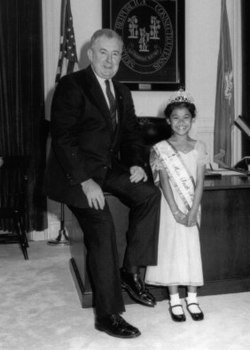| No.[b] |
Governor |
Term in office |
Party |
Election |
Lt. Governor[c][d] |
|---|
| 1 |
 |
|
Jonathan Trumbull Sr. |
October 10, 1776
–
May 13, 1784
(not candidate for election) |
No party |
1776[e] |
|
Matthew Griswold |
| 1777 |
| 1778 |
| 1779 |
| 1780 |
| 1781 |
| 1782 |
| 1783 |
| 2 |
|
|
Matthew Griswold |
May 13, 1784
–
May 11, 1786
(lost election)[5] |
Federalist |
1784 |
Samuel Huntington |
| 1785 |
| 3 |
 |
Samuel Huntington |
May 11, 1786
–
January 5, 1796
(died in office) |
Federalist |
1786 |
Oliver Wolcott |
| 1787 |
| 1788 |
| 1789 |
| 1790 |
| 1791 |
| 1792 |
| 1793 |
| 1794 |
| 1795 |
| 4 |
 |
Oliver Wolcott Sr. |
January 5, 1796
–
December 1, 1797
(died in office) |
Federalist |
Lieutenant
Governor
acting as
Governor |
Acting as Governor |
| 1796 |
Jonathan Trumbull Jr. |
| 1797 |
| 5 |
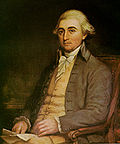 |
Jonathan Trumbull Jr. |
December 1, 1797
–
August 7, 1809
(died in office) |
Federalist |
Lieutenant
Governor
acting as
Governor |
Acting as Governor |
| 1798 |
John Treadwell |
| 1799 |
| 1800 |
| 1801 |
| 1802 |
| 1803 |
| 1804 |
| 1805 |
| 1806 |
| 1807 |
| 1808 |
| 1809 |
| 6 |
 |
John Treadwell |
August 7, 1809
–
May 9, 1811
(lost election)[6] |
Federalist |
Lieutenant
Governor
acting as
Governor |
Acting as Governor |
| 1810 |
Roger Griswold |
| 7 |
|
Roger Griswold |
May 9, 1811
–
October 25, 1812
(died in office) |
Federalist |
1811 |
John Cotton Smith |
| 1812 |
| 8 |
 |
John Cotton Smith |
October 25, 1812
–
May 8, 1817
(lost election) |
Federalist |
Lieutenant
Governor
acting as
Governor |
Acting as Governor |
| 1813 |
Chauncey Goodrich
(died August 18, 1815) |
| 1814 |
| 1815 |
| Vacant |
| 1816 |
|
Jonathan Ingersoll[f]
(died January 12, 1823) |
| 9 |
 |
|
Oliver Wolcott Jr. |
May 8, 1817
–
May 2, 1827
(lost election) |
Toleration
Republican |
1817 |
| 1818 |
| 1819 |
| 1820 |
| 1821 |
| 1822 |
| Vacant |
| 1823 |
|
David Plant[g] |
| 1824 |
| 1825 |
| 1826 |
| 10 |
 |
Gideon Tomlinson |
May 2, 1827
–
March 2, 1831
(resigned)[h] |
Democratic-
Republican |
1827 |
John Samuel Peters[g] |
| 1828 |
| 1829 |
| 1830 |
| 11 |
 |
|
John Samuel Peters |
March 2, 1831
–
May 1, 1833
(lost election) |
National
Republican |
Lieutenant
Governor
acting as
Governor |
Acting as Governor |
| 1831 |
Thaddeus Betts |
| 1832 |
| 12 |
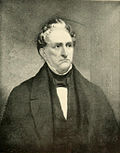 |
|
Henry W. Edwards |
May 1, 1833
–
May 7, 1834
(lost election) |
Democratic |
1833 |
|
Ebenezer Stoddard |
| 13 |
 |
|
Samuel A. Foot |
May 7, 1834
–
May 6, 1835
(lost election) |
Whig |
1834 |
|
Thaddeus Betts |
| 14 |
 |
|
Henry W. Edwards |
May 6, 1835
–
May 2, 1838
(not candidate for election) |
Democratic |
1835 |
|
Ebenezer Stoddard |
| 1836 |
| 1837 |
| 15 |
 |
|
William W. Ellsworth |
May 2, 1838
–
May 4, 1842
(lost election) |
Whig |
1838 |
|
Charles Hawley |
| 1839 |
| 1840 |
| 1841 |
| 16 |
 |
|
Chauncey Fitch Cleveland |
May 4, 1842
–
May 1, 1844
(lost election) |
Democratic |
1842 |
|
William S. Holabird |
| 1843 |
| 17 |
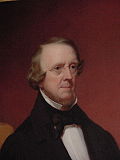 |
|
Roger Sherman Baldwin |
May 1, 1844
–
May 6, 1846
(not candidate for election) |
Whig |
1844 |
|
Reuben Booth |
| 1845 |
| 18 |
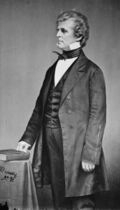 |
|
Isaac Toucey |
May 6, 1846
–
May 5, 1847
(not candidate for election) |
Democratic |
1846 |
|
Noyes Billings |
| 19 |
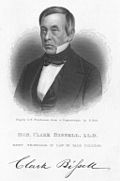 |
|
Clark Bissell |
May 5, 1847
–
May 2, 1849
(not candidate for election) |
Whig |
1847 |
|
Charles J. McCurdy |
| 1848 |
| 20 |
 |
Joseph Trumbull |
May 2, 1849
–
May 4, 1850
(not candidate for election) |
Whig |
1849 |
Thomas Backus |
| 21 |
 |
|
Thomas H. Seymour |
May 4, 1850[i]
–
October 13, 1853
(resigned)[j] |
Democratic |
1850 |
|
Charles H. Pond |
| 1851 |
|
Green Kendrick |
| 1852 |
|
Charles H. Pond |
| 1853 |
| 22 |
 |
Charles H. Pond |
October 13, 1853
–
May 3, 1854
(not candidate for election) |
Democratic |
Lieutenant
Governor
acting as
Governor |
Acting as Governor |
| 23 |
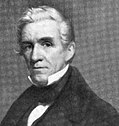 |
|
Henry Dutton |
May 3, 1854
–
May 2, 1855
(lost election) |
Whig |
1854 |
|
Alexander H. Holley |
| 24 |
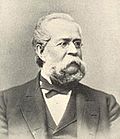 |
|
William T. Minor |
May 2, 1855
–
May 6, 1857
(not candidate for election) |
American |
1855 |
|
William Field |
| 1856 |
Albert Day |
| 25 |
 |
|
Alexander H. Holley |
May 6, 1857
–
May 5, 1858
(not candidate for election) |
Republican |
1857 |
|
Alfred A. Burnham |
| 26 |
 |
William Alfred Buckingham |
May 5, 1858
–
May 2, 1866
(not candidate for election) |
Republican |
1858 |
Julius Catlin |
| 1859 |
| 1860 |
| 1861 |
Benjamin Douglas |
| 1862 |
Roger Averill |
| 1863 |
| 1864 |
| 1865 |
| 27 |
 |
Joseph Roswell Hawley |
May 2, 1866
–
May 1, 1867
(lost election) |
Republican |
1866 |
Oliver Winchester |
| 28 |
 |
|
James E. English |
May 1, 1867
–
May 5, 1869
(lost election) |
Democratic |
1867 |
|
Ephraim H. Hyde |
| 1868 |
| 29 |
 |
|
Marshall Jewell |
May 5, 1869
–
May 4, 1870
(lost election) |
Republican |
1869 |
|
Francis Wayland III |
| 30 |
 |
|
James E. English |
May 4, 1870
–
May 16, 1871
(lost election)[k] |
Democratic |
1870 |
|
Julius Hotchkiss |
| 31 |
 |
|
Marshall Jewell |
May 16, 1871
–
May 7, 1873
(not candidate for election) |
Republican |
1871[k] |
|
Morris Tyler |
| 1872 |
| 32 |
 |
|
Charles Roberts Ingersoll |
May 7, 1873
–
January 3, 1877
(not candidate for election) |
Democratic |
1873 |
|
George G. Sill |
| 1874 |
| 1875[l] |
| 33 |
 |
Richard D. Hubbard |
January 3, 1877
–
January 9, 1879
(lost election) |
Democratic |
1876[m] |
Francis Loomis |
| 34 |
 |
|
Charles B. Andrews |
January 9, 1879[n]
–
January 5, 1881
(not candidate for election) |
Republican |
1878 |
|
David Gallup |
| 35 |
 |
Hobart B. Bigelow |
January 5, 1881
–
January 3, 1883
(not candidate for election) |
Republican |
1880 |
William H. Bulkeley |
| 36 |
 |
|
Thomas M. Waller |
January 3, 1883
–
January 8, 1885
(lost election) |
Democratic |
1882 |
|
George G. Sumner |
| 37 |
 |
|
Henry Baldwin Harrison |
January 8, 1885[o]
–
January 7, 1887
(not candidate for election) |
Republican |
1884 |
|
Lorrin A. Cooke |
| 38 |
 |
Phineas C. Lounsbury |
January 7, 1887[p]
–
January 10, 1889
(not candidate for election) |
Republican |
1886 |
James L. Howard |
| 39 |
|
Morgan Bulkeley |
January 10, 1889[q]
–
January 4, 1893
(not candidate for election) |
Republican |
1888 |
Samuel E. Merwin |
| 1890[r] |
| 40 |
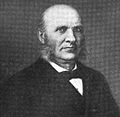 |
|
Luzon B. Morris |
January 4, 1893
–
January 9, 1895
(not candidate for election) |
Democratic |
1892 |
|
Ernest Cady |
| 41 |
 |
|
Owen Vincent Coffin |
January 9, 1895
–
January 6, 1897
(not candidate for election) |
Republican |
1894 |
|
Lorrin A. Cooke |
| 42 |
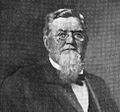 |
Lorrin A. Cooke |
January 6, 1897
–
January 4, 1899
(not candidate for election) |
Republican |
1896 |
James D. Dewell |
| 43 |
 |
George E. Lounsbury |
January 4, 1899
–
January 9, 1901
(not candidate for election) |
Republican |
1898 |
Lyman A. Mills |
| 44 |
 |
George P. McLean |
January 9, 1901
–
January 7, 1903
(not candidate for election) |
Republican |
1900 |
Edwin O. Keeler |
| 45 |
 |
Abiram Chamberlain |
January 7, 1903
–
January 4, 1905
(not candidate for election) |
Republican |
1902 |
Henry Roberts |
| 46 |
 |
Henry Roberts |
January 4, 1905
–
January 9, 1907
(not candidate for election) |
Republican |
1904 |
Rollin S. Woodruff |
| 47 |
 |
Rollin S. Woodruff |
January 9, 1907
–
January 6, 1909
(not candidate for election) |
Republican |
1906 |
Everett J. Lake |
| 48 |
 |
George L. Lilley |
January 6, 1909
–
April 21, 1909
(died in office) |
Republican |
1908 |
Frank B. Weeks |
| 49 |
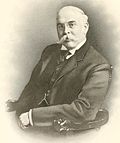 |
Frank B. Weeks |
April 21, 1909
–
January 4, 1911
(not candidate for election) |
Republican |
Lieutenant
Governor
acting as
Governor |
Acting as Governor |
| 50 |
|
|
Simeon Eben Baldwin |
January 4, 1911
–
January 6, 1915
(not candidate for election) |
Democratic |
1910 |
Dennis A. Blakeslee[s] |
| 1912 |
|
Lyman T. Tingier |
| 51 |
 |
|
Marcus H. Holcomb |
January 6, 1915
–
January 5, 1921
(not candidate for election) |
Republican |
1914 |
|
Clifford B. Wilson |
| 1916 |
| 1918 |
| 52 |
 |
Everett J. Lake |
January 5, 1921
–
January 3, 1923
(not candidate for election) |
Republican |
1920 |
Charles A. Templeton |
| 53 |
 |
Charles A. Templeton |
January 3, 1923
–
January 7, 1925
(not candidate for election) |
Republican |
1922 |
Hiram Bingham III |
| 54 |
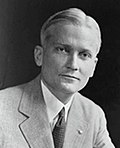 |
Hiram Bingham III |
January 7, 1925
–
January 8, 1925
(resigned)[t] |
Republican |
1924 |
John H. Trumbull |
| 55 |
|
John H. Trumbull |
January 8, 1925
–
January 7, 1931
(not candidate for election) |
Republican |
Lieutenant
Governor
acting as
Governor |
Acting as Governor[u] |
| 1926 |
J. Edwin Brainard |
| 1928 |
Ernest E. Rogers |
| 56 |
 |
|
Wilbur Lucius Cross |
January 7, 1931
–
January 4, 1939
(lost election) |
Democratic |
1930 |
Samuel R. Spencer[s] |
| 1932 |
Roy C. Wilcox[s] |
| 1934 |
|
T. Frank Hayes |
| 1936 |
| 57 |
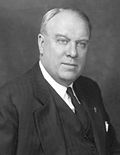 |
|
Raymond E. Baldwin |
January 4, 1939
–
January 8, 1941
(lost election) |
Republican |
1938 |
|
James L. McConaughy |
| 58 |
|
|
Robert A. Hurley |
January 8, 1941
–
January 6, 1943
(lost election) |
Democratic |
1940 |
|
Odell Shepard |
| 59 |
 |
|
Raymond E. Baldwin |
January 6, 1943
–
December 27, 1946
(resigned)[v] |
Republican |
1942 |
|
William L. Hadden |
| 1944 |
|
Charles Wilbert Snow[w] |
| 60 |
|
|
Charles Wilbert Snow |
December 27, 1946
–
January 8, 1947
(successor took office) |
Democratic |
Lieutenant
Governor
acting as
Governor |
Acting as Governor |
| 61 |
|
|
James L. McConaughy |
January 8, 1947
–
March 7, 1948
(died in office) |
Republican |
1946 |
|
James C. Shannon |
| 62 |
|
James C. Shannon |
March 7, 1948
–
January 5, 1949
(lost election) |
Republican |
Lieutenant
Governor
acting as
Governor |
Acting as Governor[x] |
| 63 |
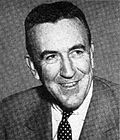 |
|
Chester Bowles |
January 5, 1949
–
January 3, 1951
(lost election) |
Democratic |
1948 |
|
William T. Carroll |
| 64 |
 |
|
John Davis Lodge |
January 3, 1951
–
January 5, 1955
(lost election) |
Republican |
1950[y] |
|
Edward N. Allen |
| 65 |
 |
|
Abraham Ribicoff |
January 5, 1955
–
January 21, 1961
(resigned)[z] |
Democratic |
1954 |
|
Charles W. Jewett |
| 1958 |
John N. Dempsey |
| 66 |
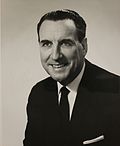 |
John N. Dempsey |
January 21, 1961
–
January 6, 1971
(not candidate for election) |
Democratic |
Lieutenant
Governor
acting as
Governor |
Acting as Governor[aa] |
| 1962 |
Samuel J. Tedesco
(resigned January 15, 1966) |
| Fred J. Doocy |
| 1966 |
Attilio R. Frassinelli |
| 67 |
 |
|
Thomas Meskill |
January 6, 1971
–
January 8, 1975
(not candidate for election) |
Republican |
1970 |
|
T. Clark Hull
(resigned June 1, 1973) |
| Peter L. Cashman |
| 68 |
 |
|
Ella Grasso |
January 8, 1975
–
December 31, 1980
(resigned)[ab] |
Democratic |
1974 |
|
Robert K. Killian |
| 1978 |
William A. O'Neill |
| 69 |
|
William A. O'Neill |
December 31, 1980
–
January 9, 1991
(not candidate for election) |
Democratic |
Succeeded from
Lieutenant
Governor |
Joseph J. Fauliso |
| 1982 |
| 1986 |
| 70 |
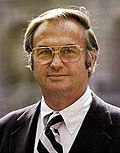 |
|
Lowell Weicker |
January 9, 1991
–
January 4, 1995
(not candidate for election) |
A Connecticut Party |
1990 |
|
Eunice Groark |
| 71 |
 |
|
John G. Rowland |
January 4, 1995
–
July 1, 2004
(resigned)[ac] |
Republican |
1994 |
|
Jodi Rell |
| 1998 |
| 2002 |
| 72 |
 |
Jodi Rell |
July 1, 2004
–
January 5, 2011
(not candidate for election) |
Republican |
Succeeded from
Lieutenant
Governor |
|
Kevin Sullivan[w] |
| 2006 |
|
Michael Fedele |
| 73 |
 |
|
Dannel Malloy |
January 5, 2011
–
January 9, 2019
(not candidate for election) |
Democratic |
2010 |
|
Nancy Wyman |
| 2014 |
| 74 |
 |
Ned Lamont |
January 9, 2019
–
present[ad] |
Democratic |
2018 |
Susan Bysiewicz |


























































